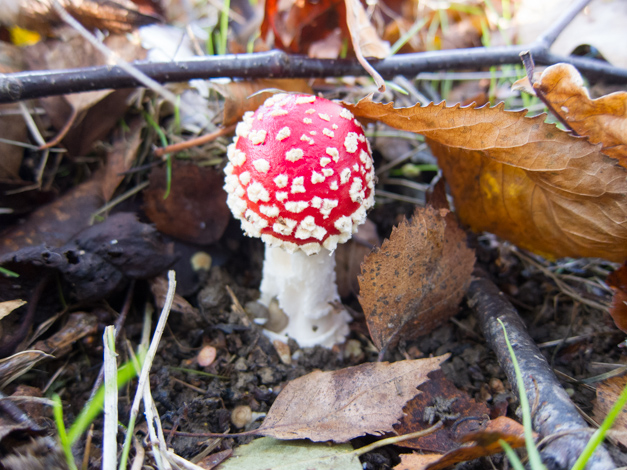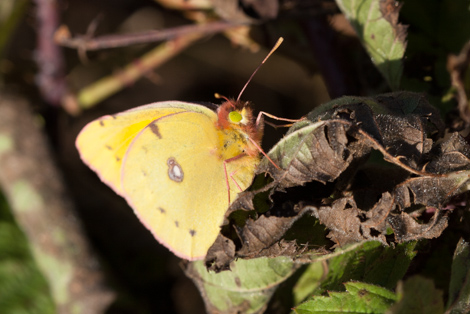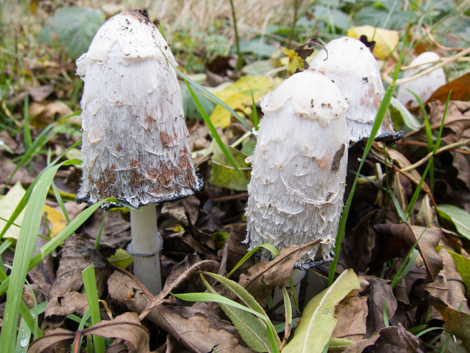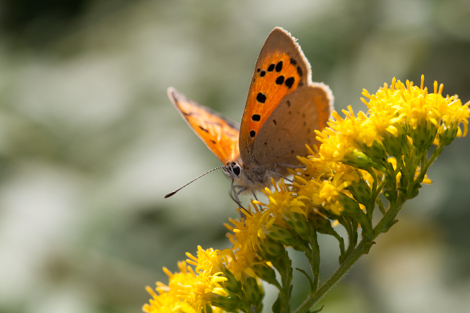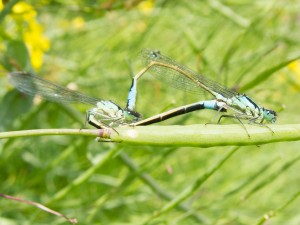And the only other fungus I can recognise without any ID keys – fly agaric, amanita muscaria. This is a young one that I unearthed (almost literally). It does actually attract (and kill) flies and has been used as an insecticide. Although poisonous, it used to be seen as a symbol of good luck and used to feature on Victorian Christmas cards. It can be found from summer through to November and, as it gets older, the cap gets flatter and more disc like. After a lot of rain, even the young caps can lose their white scales and become plain red so it is a good job I found this on Saturday, before the rains came.
Category: Nature
It’s not too late for butterflies…
Once the clocks go back at the end of October I start thinking about spring and the return of the insects. However, if the weather is warm there is still the chance to catch a few insects still on the wing. Wasps, flies and hoverflies are feeding on the last of the ivy flowers, and a few red admirals are sometimes be seen on windfall fruits and any remaining blackberries. However, the first of November this year yielded reports of 11 different butterfly species. I’m not sure if this is a record, but it certainly seems unusual.
What was more exciting for me was that in addition to the aforementioned admirable reds, I saw my second ever clouded yellow butterfly (colias croceus) and, I had a camera with me. This caught my eye initially because it looked like a leaf fluttering, but I soon realised it was a butterfly. A much deeper yellow than the brimstone which isn’t usually seen this late in the year, the clouded yellow is a migrant to the UK but once here as many as three broods can be produced in one year. Although not visible from the underside of the wings, the butterfly has a black border round the edges of the upper surface of the wings which gives rise to the clouded part of its name. The two sexes can be differentiated by the row of spots that are present in this border on the females. Unfortunately I didn’t get a chance to see this one close up when in flight so have no idea whether it was a girl or boy butterfly. Not that it matters, it was still an exciting find for any time of year, but more so for November.
White toadstools popping up near you this autumn
I’m not very good at recognising different types of mushrooms and toadstools. I’ve been on an organised fungi foray over at Gamlingay Woods, I’ve taken pictures and put them on iSpot, but I can rarely remember what they are called or remember having seen them before. In fact I can count on two fingers the ones I can recognise and name immediately on sight. This, is one of them.
This is a shaggy ink cap (Coprinus comatus) – comatus means hairy and refers to the scales that are clear once the cap has pushed out of the ground. They pop up all over the place and are widespread across Europe and North America. In fact, if you are an urban naturalist then you are in luck because they are often found in the green spaces in towns.
They first form as little egg-shaped white caps peeping out of the soil, and, as they grow the gills turn from white to pink to black as they liquefy themselves to death from the edges forming an inky like substance as they spread their spores. In the end there is just a white stem with some inky remains at the top.
They are supposedly edible, although not that tasty and not poisonous, but have to be eaten pretty quickly as they will have liquified themselves within a couple of hours of picking. However, as with all mushrooms you need to really know your stuff to prevent accidentally picking something poisonous.
Small is beautiful
Ryton gardens, sunshine and a glint of pure copper, a mini beast photographer (that’s photographer who takes pictures of mini beasts) can’t ask for anything more.
Unlike the plethora of white butterflies that were out that afternoon, the small copper is an unmistakeable butterfly. Although it is paler on the underside (looking a bit like a common blue – they are the same family after all) the bright copper that it shows when it sits with its wings open resembles no other butterfly – the gatekeeper looks drab by comparison.
Small coppers are likely to be around until mid-October (unless we get very cold weather) and have up to three broods in a year. The first broods are typically on the wing in early May, a larger brood is around for about a month from mid July and then a final brood occurs from the middle of September into October. Eggs are usually laid on sorrel or dock leaves (guess what I will be planting next year in case any small coppers are reading this) and apparently are white and disc like and look a bit like the surface of a golf ball – I’ll let you know if I see one. The green caterpillars that emerge are about for around a month before pupating into the beautiful adults. The exception being those from the last brood as this is a butterfly that overwinters as a caterpillar.
However, small coppers are apparently very prone to variation in spot size and number and the copper varies in shade with white and brown versions sometimes seen. And there I was thinking this was a truly unmistakeable butterfly!
Although the butterfly is quick and a bit flighty, males are quite territorial and if you wait for a while they are likely to come back to the same spot. As shown in this photo, yellow flowers appear to be a bit of a favourite with these butterflies.
On the wing
So I set off last weekend to see how my tern chick was getting along – although secretly I was a little worried that it might still have been small enough to make a tasty meal for the herring gulls that periodically flew over the rafts.
But, worry not. I think the chick was still alive and well, but it was difficult to tell. In fact, I counted 5 juvenile terns – chicks seems an inappropriate term now as they were not at all fluffy and looked very similar to the adults. There were some differences in appearance and behaviour though to help me out. Although they were mainly grey and white, there were some noticeable brown feathers on the wings, the tails seemed a bit short and the beaks had a bit of a yellow-orange look compared to the bright red of their parents. They spent most of their time perched on the edge of the tern rafts – with the occasional foray into flight. However, the landings looked a bit on the clumsy side and I was convinced that one of them was sooner or later going to miss.
When I watch an adult tern they seem almost effortless, with languid wing strokes; in comparison the youngsters seem almost panicky: flap, flap, flap in case they crash into the water. They were also still reliant on their parents for food, with loud shouts every time one came near with fish.
Two days later and it was all change again. Lots of terns were out above the water, resting in the rafts or just perching on the fence posts at the edge of the water. The youngsters were out and about as well. We watched one following or being followed by an adult. It seemed that it was learning how to fish. It wasn’t very successful, but was definitely persistent. At first it was patient, trying the occasional dive and then flying off a little further. After a while though I think it was getting a little more desperate – it would hover above, dive, then come back up and quickly dive back down again. Eventually the parent shadowing it showed how it was done and gave the youngster a fishy reward for its efforts.
Whilst I am really pleased to see that at least 5 chicks have been successfully reared by the terns, watching them made me a little sad as I realised that before long they will be on their way again.
The black-headed gulls are now drifting back to the country park to fill in the gap the terns will leave. Does that mean summer is nearly over?
Big news in the tern report
As seems to be usual for this time of year it was quiet out on the water at the Country Park. The gulls were sitting quietly (for the most part) at the far end, the coots seem to have invaded a couple of the tern rafts and the others were occupied by snoozing or preening terns.
The swans and their six cygnets cruised serenely past at one point, and a youngish great crested grebe chick decked out in his stripy best was, as grebe chicks usually are, loudly demanding lunch from its parent.
However, closer inspection, and a lot of waiting, revealed a lot more happening in the elegant world of the terns (imagine a note of sarcasm when reading the word elegant please). Out on the newer tern raft there seemed to be an almost permanent group of up to five terns sat around the edge. I saw some bringing of fish and worked out that there are at least three different pairs nesting there. Most of the time there was just a bit general screeching when a fish carrying tern arrived. But for some reason, one poor tern carrying what looked like a small perch (well, it had a red tail) was attacked by one of the by-standing terns. Not only did it stop it from landing, it chased it high into the air, followed it round and round the raft and at one point had it in the water and seemed intent on drowning the poor bird. I’m not sure if it was the tern that caused such a reaction or a desire to possess a red-tailed fish, but I didn’t see any other tern suffering from such attention. I also lost the chase and so don’t know what became of the tern or fish.
Another strange piece of behaviour was from a tern that had caught a fine silver fish but which seemed intent on shouting about it. He flew across the water, calling as he went, then I think he went halfway into Daventry and back, calling all the time, and then did another partial circuit of the reservoir. I didn’t see him try to land anywhere or offer the fish. He just seemed to be particularly proud of his catch.
However, I’ve saved the big news until the end of my Tern Report. There has been a hatching out on one of the rafts. I thought the adult was just resting, but every now and then I saw a little brown and black head pop up and wander about. I was beginning to get a little concerned when there had been no attempt to bring in fish by any of the patrolling terns for at least an hour. Then, suddenly both adult and chick started calling bright orange-red beaks open wide, and, sure enough in came an adult to give a fish to the chick before heading off again. We saw him make three deliveries in fairly rapid succession before it disappeared for a longer hunt.
We therefore wondered, do the adults feed themselves first before doing some dedicated chick feeding – the adult didn’t seem to have too much trouble finding fish, so there has to be some explanation for the earlier absence? Answers on a postcard please.
The Tern Report
Forgive me reader for it has been two weeks since I visited my terns. Fortunately not much has changed and the tern rafts are still afloat. At first I was worried as it was very quiet out on the water, but I soon saw a tern patrolling the edge along the dam. When I got the telescope out I discovered that there were a few birds out hunting, but the majority were quietly sat on the tern rafts. I think there must have been around a dozen birds scattered across the rafts.
The only noise seemed to occurred when another tern came near. The rest of the time they were either snoozing, preening or wandering about on the raft, I assumed checking out their territory or displaying to their mate. I did see one exchange of fish, but this was away from the tern raft. I also witnessed tern sex so I am hopeful that some egg laying might be on the cards.
It then occurred to me that I know nothing about terns and have no idea how long eggs would take to hatch so some research was in order. Terns lay up to four eggs in the space of about four days, but continue to mate during this time. Although both sexes will incubate the egg this is apparently sometimes a bit sporadic – this could explain why there was a fair amount of standing about – the terns often stand next to the egg. After the third or fourth egg is laid they then settle down to some more sustained incubation.
I’ll have to wait for somewhere between about 23 and 28 days for the eggs to hatch – so hopefully I will see some changes in behaviour around the middle of July. Then there will be a lot more hunting for fish by the parents for the next month until the young fledge. I’m hopeful that as the terns seem to come back each year (terns can live up to about 25 years) then they must have successfully bred at some point. This time I’ll hopefully be watching.
Of damselflies and demoiselles
During my bioblitz I noticed a couple of types of damselfly in my garden – strangely none emerging from the pond. I’d also noticed some at the Country Park during Tern watch. I shouldn’t really have been surprised when I found some during my lunchtime sojourn to the River Nene. I did notice quite a few darting about, thin electric blue insects, nervously settling, but moving as soon as I made even the slightest move in their direction. I gave up trying to photograph them, they weren’t playing. So I wandered off to look for hoverflies and warblers.
It was then that I spotted the demoiselle – the most beautiful insect created. If you have no idea what I’m talking about then Google it. I couldn’t take a photograph because it was off in the reed beds, but I did look at it through my binoculars. They are breathtakingly lovely.
Whilst I was making my way back looking for bees and bugs I stumbled across some mating damselflies – I almost missed them. They were sufficiently distracted to stay still long enough for a photo.
I then found a female ovipositing on a leaf further along the path. She was also obliging to a would-be insect identifier.
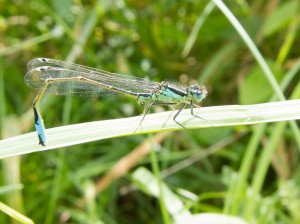 I thought that these were probably the same as the other blue damsels I had seen, but when I got out my excellent field guide I discovered these were blue-tailed damselflies. Just as common as the azure and blue-tailed varieties, not as beautiful as the demoiselle, but they are the only ones I caught on camera and properly ID’d today!
I thought that these were probably the same as the other blue damsels I had seen, but when I got out my excellent field guide I discovered these were blue-tailed damselflies. Just as common as the azure and blue-tailed varieties, not as beautiful as the demoiselle, but they are the only ones I caught on camera and properly ID’d today!
The Tern Report
So, feeling bad about not checking on my terns, I’ve paid two visits this week. First, an evening trip after work on Monday. The majority of the noise and activity was from the tern rafts – other birds such as the swifts were not present in great numbers and the big gulls were still down at the far end of the water.
The birds seemed to be busy setting up territories with quite a bit of squabbling going on when an interloper tried to land – they could land on certain parts of the raft, but not others. Most parts of the raft had only one bird in place – mainly sitting, have a preen or shouting at the other terns. Sitting around the edge of the raft in general seemed to be tolerated, particularly on the larger, higher new raft. Landing, within the confines less so. I did see some digging around by a couple of birds – not sure what they were digging into or if it was some sort of bonding ritual, and I also saw the presentation of a newly caught fish from one tern to another – that seemed much clearer. I left feeling that all was well with my terns and looking forward to watching them next weekend.
However, the weather in between then and now has been terrible -strong winds, thunder, lightning and lots of rain. The results were fairly predictable. Returning today (Sunday) it was noticeable that a number of the older, shallower rafts were under water to some extent again. Whilst they were occupied I think it was just somewhere for the terns to sit and have a rest. I hope that none had laid their eggs in the last week – if they did, will they lay again? I have no idea. The other, more robust rafts, were still occupied although I’m not sure how many birds were there – I saw the tips of some wing feathers peeking over the top but couldn’t be certain that there were more than a couple of birds in residence.
I did get a good view of the terns fishing – they looked beautiful backlit by the sun, at times almost hovering, wings and tail spread, at other times they zoomed past so fast on the gusts of wind they appeared as just a white flash through my telescope. More wet weather is forecast for the coming week – I just hope that the birds sit tight and keep away from those old rafts.
The water is quite quiet apart from the terns at the moment, but I did notice a fairly sizeable chick with one of the great crested grebes – I guess they nested quite early this year. Note to self – find out when great crested grebes usually nest.
No time for terns this week
I didn’t make it to see the terns with my spotting scope this weekend – too busy Saturday, too sunny Sunday. However, I did go past them early on Sunday morning, unfortunately without any additional viewing aids. They were pretty quiet, not many flying about and I think one of the tern rafts had been abandoned as it had mallards sitting around the edge – will check later this week with a bit of luck.
However, I did hear the skylark singing again, despite all the housebuilding that is going on adjacent to the country park and I noticed that the swans had four cygnets – little fluffy grey balls of cute. All else remained quiet on the water, even the swifts and house martins appeared to have gone somewhere else.
